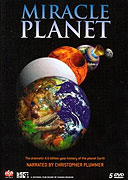
Regie:
Hideki TasukeBesetzung:
Christopher Plummer, Tsutomu Yamazaki, James Kasting, Jean-Michel Geneste, Peter H. Schultz, Peter WardInhalte(1)
Miracle Planet is a five-part series that recounts the profound and gripping story of Earth's mysterious evolution. Narrated by Christopher Plummer , it reveals the surprising role that sheer chance has played in the development of life. Over its more than 4-billion-year history, Earth has been home to repeated violent climactic changes, which have caused mass extinctions. And yet, life has survived. In fact, these same catastrophes that devastated life on Earth also helped bring about its evolution from the simplest microbes to the complexity and diversity that is found on the planet today. Filmed in High Definition this series features location footage, interviews with the world's foremost scientists and cutting-edge computer technology.
Programs in this series:
The Violent Past
Earth is a planet born in fire and baptized in ice. Earth grew from the collision of many smaller planets, drawn together by Earth' s gravitational force and melted together from the force and heat of the impact. Some scientists posit the idea that first life emerged on Earth 4.4 billion years ago, and the likely source was simple organisms originating from Mars, as rocks from that planet hurtled through space to land on ours.
Snowball Earth
Over the ages, continents have shifted their positions, wind and rain shaping and reshaping the surface. Scientists believe that at least two total ice ages have occurred, each lasting for millions of years. But life in the simplest form might have been able to survive in the depths of the oceans, living from the heat and energy that comes from the Earth itself.
New Frontiers
From microbes to the first complex creatures, life was always searching for new frontiers. By 450 million years ago, Earth had become a less violent planet - no longer bombarded by giant meteors from space and the great ice ages had passed. Nothing yet lived on the land, but in the warm and shallow seas that fringed the continents, there was a rich diversity of life. Around this time, fossils capture long extinct creatures on the evolutionary path, aquatic organisms defined by jaws and early limbs.
Extinction and Rebirth
The dinosaurs would roam the Earth and ruled for millions of years, until a disaster from space wiped them out and cleared the way for the mammals to rise and dominate the planet. With the early mammals, many steps including the development of opposable thumbs, the ability to walk on two legs and sharper eyesight - would lay the groundwork for primates and the birth of humanity.
Survival of the Fittest
The human race is here today because of its ability to adapt. Our ancestors, the earliest mammals, survived low oxygen levels. Later primates developed sharp eyesight and hands that could clasp for nocturnal life in trees. And about 6 million years ago, fossil evidence in Africa tells us, some primates may have begun to walk upright, perhaps because they were forced out of the trees and into the grasslands. Living on Earth truly was the Survival of the Fittest.
(Verleiher-Text)